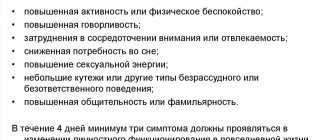general characteristics
The development of the disease depends on the nature and duration of the psychotrauma, the state of mental defense, and personality characteristics.
Another name for the disorder is psychogenic psychosis. Experts also use the terms psychogenic, reactive state, psychogenic reaction, psychogenic shock, situational psychosis. Foreign researchers describe such conditions as psychogenic, stress or abnormal reactions.
The main difference between this type of psychotic disorder is the complete reversibility of their development after the cessation of the traumatic cause or as a result of treatment of the disease.
Active study of reactive states began at the end of the 19th century. Information accumulated during the Civil War (1917 - 1922) significantly expanded knowledge about them. Most medical researchers have recognized psychogenic diseases as an independent nosological entity.
The German psychiatrist K. Jaspers in 1946 identified the main clinical signs for diagnosing reactive diseases, which were called the triad:
- the disease occurs as a result of psychological trauma;
- manifestations of psychogenic disorders are associated with intense exposure to adverse factors or stress on the psyche;
- obligatory extinction of the severity of symptoms after the cessation of the effect of psychotrauma.
The relevance of this triad remains today. At the end of the 20th century, Russian scientists confirmed that 60-80% of people who were under severe stress develop reactive psychoses.
Moreover, their varieties are not combined into one heading of the International Classification of Diseases, but are included in various blocks and classes.
The manifestations of each of them are varied, radically different, and therefore are included in various groups of diseases.
Psychosis is often detected in patients with borderline states. Some of them, especially neuroses, are often identified with psychogenic disorders. The main reason for this is considered to be external influence on the psyche.
But the reaction to a psychogenic factor is, first of all, psychogeny. At the same time, the ability to critically assess one’s condition and interact with the social environment is temporarily but completely lost.
Types of Personality Disorders
In accordance with the classification described in the International Guide to Mental Disorders, personality disorders are divided into three fundamental categories (clusters):
- Cluster “A” is eccentric pathologies, these include schizoid, paranoid, schizotypal disorder;
- Cluster “B” is emotional, theatrical or fluctuating disorders, which include borderline, hysterical, narcissistic, antisocial disorder;
- Cluster “C” is anxiety and panic disorders: obsessive-compulsive disorder, dependent and avoidant personality disorder.
The described types of personality disorders differ in etiology and mode of expression. There are several types of classifications of personality pathologies. Regardless of the classification used, various personality pathologies can simultaneously be present in one individual, but with certain limitations. In this case, the most pronounced symptoms are usually diagnosed. The types of personality disorders are described in detail below.
2.1. Disturbances of consciousness and self-awareness
In psychiatry, a “working” definition of consciousness is used, which differs from its philosophical and psychological understanding. A disordered, “clouded” consciousness is contrasted with a “clear” consciousness. The term “clear consciousness” refers to such a mental state of a person in which he retains the ability to give an account of the place, time, environment, state and mode of action of his own personality.
1) disorientation - complete or partial disruption of orientation in time, place, one’s own personality;
2) vagueness, fragmentation, disorder of perception of the surrounding world;
3) different degrees of incoherence of thinking (difficulties in analysis and synthesis, establishing cause-and-effect relationships);
4) amnestic disorders: inaccuracy, fragmentation or lack of memories of what was experienced during the period of upset consciousness;
5) the severity of occurrence and the relative short duration of these conditions.
Types of impaired consciousness
1) non-productive (states of switching off consciousness): stupor, stupor, coma;
2) productive (states of stupefaction): delirium, oneiroid, amentia, twilight disorder of consciousness.
Disorders of self-awareness
K. Jaspers identified the following main signs of self-awareness, the violation of which is typical in mental pathology:
- sense of activity - awareness of oneself as an active being;
- awareness of one’s own unity at every moment of time;
- awareness of one's own identity;
- the awareness that “I” is different from the rest of the world, from everything that is not “I”.
Depersonalization is a violation of self-awareness, expressed in alienation from oneself, from one’s “I”. It may concern both individual somatic or mental functions and the personality as a whole. Subjectively, it is always unpleasant and can exist for a long time or manifest itself in attacks.
1. Get acquainted with the clinical manifestations of disorders of consciousness and self-awareness according to [1].
2. What mental dysfunctions are signs of darkened consciousness?
Literature
1. Zeigarnik Pathopsychology. – M., 1986. P.49-57.
2. Sidorov P.I., Parnyakov A.V. Introduction to Clinical Psychology. – M., 2000. – T. 1. – P.272-301
Diagnosis of personality disorder
The main criteria for the differential diagnosis of a personality disorder are poor subjective well-being, loss of social adaptation and performance, and disturbances in other areas of life. To make a correct diagnosis, it is important for the doctor to determine the stability of the pathology, take into account the cultural characteristics of the patient, and compare it with other types of mental disorders. Basic diagnostic tools:
- checklists;
- self-esteem questionnaires;
- structured and standardized patient interviews.
Etiology of development and risk factors
The pathogenesis of psychogenic diseases is based on severe mental shock. But psychotrauma does not cause illness in every person.
More often, reactive psychosis is detected in accentuated individuals with pronounced character traits that are within normal limits, but border on pathology. Also emotionally vulnerable - unstable, highly reactive, hysterical, paranoid people.
There are risk factors that are most likely to develop psychogenic disorders:
- neuropsychic weakness, impotence, fatigue (asthenia);
- traumatic brain injury (TBI);
- genetic predisposition;
- severe somatic and infectious diseases;
- physiological changes in hormonal levels (puberty, pregnancy, childbirth, menopause);
- gender (women get sick more often than men);
- intoxication of the body (alcohol, drugs, medicinal substances);
- vitamin deficiency, especially lack of vitamins B1 and B3.
The likelihood of detecting the disease in a child whose family suffers from psychosis is very high.
Signs of a Personality Disorder
Let's consider several criteria that the symptoms of a personality disorder must meet:
- There is a tangible contradiction in the life positions and behavior of the person, affecting several mental spheres.
- A destructive, unnatural model of behavior was formed in a person a long time ago and is chronic in nature, not limited to periodic episodes of mental pathology.
- An abnormal behavioral manner is global and significantly complicates or makes it impossible for a person to adapt normally to diverse life situations.
- Symptoms of the disorder are always first observed in childhood or adolescence and continue to be demonstrated into adulthood.
- The pathological condition is a strong and pervasive distress, but this fact can only be recorded as the personality disorder worsens.
- An abnormal mental status can lead, but not always, to a significant deterioration in the quality and volume of work performed and cause a decline in social effectiveness.
2.2. Perception disorders
- Clinical phenomenology of perceptual disorders
a) Pathology of sensations, manifested in their pathological weakening, intensification, distortion or loss. Some of these symptoms occur not only in mental, but also in neurological, infectious, and general somatic diseases.
b) Agnosia - various types of recognition disorders with relative preservation of elementary sensations and intelligence. They are the object of study of neuropsychology.
c) “Deceptions of the senses”: illusions and hallucinations;
Illusions are a distorted perception of really existing objects.
Hallucinations are imaginary perceptions, or perceptions without an object.
d) Psychosensory disorders are perception disorders that arise on the basis of disturbances in sensory synthesis. They occur in states of impaired consciousness during organic and endogenous psychoses, as well as in experiments in healthy people after taking LSD, mescaline, and hashish.
Personality disorders - research methods
- EEG
- MRI/CT
- Psychological methods (MMPI, thematic apperception test, Rorschach test). Differential diagnosis
- Schizophrenia
- Mental retardation
- Substance abuse disorders
- Mood disorders
- Personality changes caused by somatic or neurological disease
- Somatoform disorders
- Obsessive-compulsive disorder.
Types of psychogenic disorders
Depending on the strength and duration of the psychotrauma, its nature, the patient’s state of health, and his personal characteristics, the following forms of psychogenic reactions are distinguished:
- acute reactive psychosis occurs suddenly, sharply, lasts several hours or days, manifests itself as agitation or retardation;
- a protracted disorder develops due to prolonged psychogenic influence, the patient is in a state of continuous severe stress from one week to a month, against the background of which depression, delusional disorder, and paranoia develop.
Acute reactive psychosis is also called an affective shock reaction, since this results in an explosion of uncontrollable emotions and disorganization of mental activity.
Acute affective and shock reactions appear after powerful psychotrauma, causing enormous mental shock and extreme fear of losing relatives and one’s life. This may be stress due to the death of loved ones, loss of property or freedom.
Affectively - shock reactions manifest themselves in two forms:
- The motor (hyperkinetic) type of disorder is characterized by agitation. The patient is terrified. Speech is disrupted or absent. Movements are “reactive”, sharp, pronounced, chaotic, constant. There is a clouding of consciousness. The patient may walk, run, or scream aimlessly. After the attack, partial amnesia is noted; he does not remember the moments of the acute state.
- With a hypokinetic reaction, motor retardation is manifested, and significant muscle tension is expressed. The patient's consciousness is confused, the sense of danger is lost. He is in a stupor, does not react to anyone or anything. This condition lasts up to 3 days. The patient may lose memory during the attack. These reactions can follow one after another.
Hysterical psychoses are also a type of acute reactive states:
- Hysterical disorder of consciousness (Ganser syndrome) is manifested by the patient’s anxiety, concentration on certain experiences, emotional imbalance, and mood swings. Orientation in space and time is disturbed.
- Psychogenic false dementia (Wernicke's pseudodementia) is a condition in which the patient cannot act clearly or think clearly. He is disoriented, does not recognize his place of residence, does not remember the past, is confused, his consciousness is confused. Answers simple questions incorrectly, but on topic. Speech and writing of words and letters are impaired. His face has a stupid smile or expresses sadness and fear.
- Puerilism is the transition of an adult’s mental activity to a child’s level. Childishness appears in his behavior and speech. Such people do not pronounce certain letters or words, grimace, play with children's toys, and get offended if their demands are not fulfilled. Adult skills are lost, sometimes only a few are retained - applying cosmetics, smoking, shaving. This condition rarely manifests itself independently, more often in parallel with false dementia.
- Emotional (hysterical) stupor is a state with motor retardation and narrowed consciousness. Characterized by strong muscle tension, the patient is motionless for a long time, but resists attempts to change the position of his body. He does not make contact and refuses to eat. A face with a fixed gaze expresses hopelessness, sadness, and anger. If the patient comes out of the stupor gradually, then signs of paralysis, an unsteady gait, and trembling in the entire body or individual parts may appear.
There are two types of protracted psychogenic psychoses - reactive depression and delusional psychosis.
Reactive depression appears after the death of loved ones, in difficult life situations. It manifests itself as depression, tearfulness, and reluctance to communicate. The patient withdraws into himself.
He endlessly searches for his guilt in what happened, fixates on the situation in order to relive it again. Suicidal thoughts may appear. A prolonged course of depression leads to autonomic disorders - loss of appetite, sleep disturbance, rapid heartbeat and others.
Reactive paranoid (delusional psychosis) is expressed by ideas and statements that do not correspond to reality. Expressed fear, confusion, anxiety, upset consciousness. Gradually, ideas become delusional, the patient cannot correctly assess his condition and behavior.
Delusions of persecution and other ideas often develop. Such psychoses are often detected in convicts, prisoners of war, and emigrants.
Causes and treatment
The causes of transient personality disorder are worsening long-term stress or severe neuro-emotional shock.
Prolonged stress usually occurs due to the following situations: - daily overstrain - for example, due to a nervous situation at work or a conflict situation at home, quarrels with loved ones; - a long wait for an important event or someone’s decision in relation to the subject; - tiring trip or journey; - going through the divorce process; - forced separation from family, friends or loved one; - domestic violence; - being in prison, etc.
Nervous-emotional shock can occur for the following reasons: death of a loved one, bankruptcy, sudden dismissal, betrayal, failures in personal life, etc. In addition to these reasons, transient personality disorder can occur as a result of accumulated psychological disorders such as insomnia, anxiety, restlessness, and permanent confusion. In such cases, TRL usually begins with acute absurdity.
In the treatment of transient personality disorder, constant monitoring is prescribed, first of all. The most commonly used medications are neuroleptics, antipsychotic therapy, and detoxification treatment. In order to prevent a recurrent attack of TRL after recovery, the patient is recommended to continue using antipsychotics for 2-3 weeks.
Clinical phenomenology of memory disorders
Hypermnesia (memory enhancement) is an involuntary revival of memory, which manifests itself in an increased ability to reproduce long-standing, insignificant, less relevant events of the past. At the same time, voluntary memorization and reproduction suffer. There is an increase in mechanical memory with a significant deterioration in logical-semantic memory indicators.
Hypomnesia is a gradual weakening of memory. Observed in cerebral atherosclerosis, epilepsy. The following dynamics of memory weakening are characteristic: 1) weakening of voluntary reproduction; 2) weakening of retention of material in memory; 3) increasing insufficiency of memorization. Characteristic is a decrease in mechanical memory at the beginning and a longer preservation of semantic memory.
Amnesia is a gap in memory, loss of memory of events of a certain period of time. It occurs both after states of impaired consciousness and in connection with gross organic lesions of the brain.
Retrograde amnesia – loss of memory of events before the onset (acute period) of the disease; may occur, for example, after a traumatic brain injury.
Anterograde amnesia is the loss of memories of events occurring after the acute period of the disease.
Fixation amnesia – loss of the ability to remember, lack of memory for current events. It is observed in senile dementia. Indicates severe memory disorders in which memorization, retention and reproduction are impaired.
General progressive amnesia consists of the loss of the ability to remember and a gradually increasing depletion of memory reserves. It is a typical symptom of senile dementia. First, recently acquired information disappears from memory, events of the current or recent past are forgotten, memories of events of the distant past are retained for a relatively longer time. At this stage of progressive amnesia, a shift of the situation into the past may occur - patients live with the experiences of their childhood and youth.
Affectogenic amnesia - certain, usually difficult experiences for a person are amnesic.
Paramnesia is a deception of memory. There are several types of paramnesia.
Pseudo-reminiscences are erroneous memories, “illusions of memory.” The patient fills the existing memory gaps with events from the more distant past.
Confabulations are inventions of memory - false memories with the conviction of their truth. Compared to pseudo-reminiscences, confabulations are more colorful, amorphous, and unstable.
Pseudo-reminiscences and confabulations are most characteristic of conditions in which the ability to remember is lost (Korsakov's syndrome, senile dementia, progressive paralysis).
Cryptomnesia is a distortion of memory in which alienation or appropriation of memories occurs. For example, what you see in a movie or read in a book is perceived as something you have experienced. Or vice versa – personal events are perceived as someone else’s.
- Pathopsychological study of memory disorders
a) the structure of mnestic activity of indirect and direct, voluntary and involuntary memorization;
b) dynamics of the mnestic process;
c) the motivational component of memory.
Amnestic syndromes have a complex structure; it is not always possible to isolate these characteristics separately; for the most part they are intertwined; However, experimentally it is often possible to isolate the leading role of one or another component.
In pathopsychology, the following forms of memory impairment have been most fully experimentally studied:
- impairment of immediate memory;
- violation of mediated memory;
- disruption of the dynamics of mental activity;
- violation of the motivational component of memory.
1. Get acquainted with the psychological study of memory disorders from the book [2].
2. What methods are used to study memory disorders?
3. What is the essence of Korsakov's syndrome, and what memory process is disrupted?
4. What is the manifestation of a violation of the dynamic side of memory?
5. What is the “Zeigarnik effect”, and how does it manifest itself in mentally ill people?
Literature
1. Bleikher V.M., Kruk I.V., Bokov N.S. Practical pathopsychology. – Rostov n/d, 1996. P. 70-84.
2. Zeigarnik B.V. Pathopsychology. – M., 1986. P. 147-169.
3. Sidorov P.I., Parnyakov A.V. Introduction to Clinical Psychology. – M., 2000. – T. 1. – P. 113-119.
Psychotic disorder - can it be cured?
20.03.2019
Psychotic disorder is a transient severe disorder of mental activity, characterized by a discrepancy between the real situation and the patient’s reaction to this situation. A person with this disease has impaired perception of the world and disorganized behavior. A patient in a state of psychosis is subject to hospitalization and treatment in a psychiatric department by a psychiatrist.
Psychosis has a different clinical picture and may consist of the following acute psychopathological disorders:
- Hallucinations: true, false.
- Productive thinking disorders: secondary and primary delusions (grandeur, damage, poisoning, persecution, invention, hypochondriacal), paranoia.
- Syndromes of impaired consciousness: delirium (alcoholic, traumatic), amentia, oneiroid, twilight stupefaction, pathological affect.
In psychiatry, psychosis is one of the levels of mental functioning. There are disorders of neurotic and psychotic levels. Neurotic and psychotic disorders differ in the degree of awareness of one's personality and reality.
At the neurotic (borderline) level, the patient retains his perception of reality, he knows where he is, what his name is, where he works, what he is sick with, has adequate criticism of his condition, and is slightly maladapted in society.
At the psychotic level, the patient perceives reality extremely incorrectly, has no criticism of his condition and current events, the strength of the emotional reaction does not correspond to the strength of the stimulus.
Types and causes of development
The disease can be primary or secondary. Primary (endogenous) psychosis is an acute psychotic disorder that occurs as an independent disease in mental disorders. Primary psychosis occurs against the background of schizophrenia, bipolar affective disorder, and endogenous depression.
- Schizophrenia. The clinical picture of the disease is varied and depends on the form and speed of the disease. The most typical psychotic manifestations: imperative (commanding) hallucinations and delusions, if this is the paranoid form. When psychosis occurs for the first time and is accompanied by schizophrenic symptoms, the patient in the emergency department is diagnosed not with “schizophrenia”, but with “acute polymorphic psychotic disorder.” The diagnosis of schizophrenia is not made because psychosis is characteristic of many diseases, and the diagnosis of schizophrenia means immediate disability, hospitalization and restriction of rights and social activities.
- Bipolar affective disorder. Psychosis in bipolar disorder occurs at the peak of depressive and manic episodes. At the height of depression, psychosis is accompanied by hypochondriacal delusions, suicidal behavior, and Cotard's syndrome. At the height of mania, this disease is manifested by superficial thinking, unrelated speech, and psychomotor agitation.
Secondary psychosis is a disturbance in the perception of the world and disorganization of behavior against the background of somatic and neurological diseases, as well as against the background of taking drugs, alcohol and medications.
Diseases causing secondary psychosis:
- Traumatic brain injury. TBI can be a direct precipitating factor, or indirectly through a seizure that occurs against the background of brain damage.
- Autoimmune pathologies. Psychotic disorder can be caused by systemic lupus erythematosus. At the beginning of its development, SLE manifests itself as delusions of grandeur, optical hallucinations, and paranoia. The disease can also occur against the background of multiple sclerosis and autoimmune thyroiditis.
- Substance use. An acute psychotic state occurs in three cases: after administration, with withdrawal syndrome and delirium. Most often, psychosis is caused by amphetamine, cocaine, cannabis, and ketamine. Psychosis in alcoholism occurs as part of the withdrawal syndrome. Intoxication psychosis is caused by poisoning with arsenic, lead, mercury and other heavy metals. The clinical picture of psychosis is varied: from simple illusions to severe forms of delusion with suicidal behavior.
- Iatrogenesis. Psychotic disorder occurs after taking certain medications: high doses of glucocorticoids, benzodiazepines, anticholinomimetics, chloroquine.
- Vascular diseases of the brain. The disease in 3-4% of cases occurs after a stroke, with damage to the middle cerebral artery. In the post-stroke state, visual and auditory hallucinations are noted. A connection between the disease and vascular dementia and Alzheimer's disease has been discovered.
- Brain tumors. Most often, the disease is caused by tumors that are located in the temporal lobe and limbic subcortical structures.
- Syndromes of metabolic disorders and malnutrition. Niemann-Pick disease, Tay-Sachs disease, mannosidosis, leukodystrophy, Wilson's disease and excessive accumulation of copper cause an acute psychotic state due to metabolic disorders and a defect in the neurotransmitter systems of the cortex and subcortex.
- Infections. The disease is provoked by neurosyphis, severe pneumonia and influenza, malaria, HIV and AIDS, toxoplasmosis. Psychotic disorder during infections is caused by involvement of the brain in the inflammatory process, severe fever, dehydration and intoxication of the central nervous system.
- Other diseases: multiple sclerosis, epilepsy, Alzheimer's disease, diseases of the endocrine glands, psychosis due to acute hormonal imbalance (postpartum psychosis in women).
How to distinguish between secondary psychosis and schizophrenic reaction:
- The presence of severe somatic illness or intoxication is established.
- Establishing the relationship between psychosis and the current state of health.
- Have there been any cases of psychoactive substance use?
- Neuropsychological examination, general and biochemical blood tests, magnetic resonance imaging, electrolyte levels.
- A history of specific schizophrenic symptoms (catatonia, deficit disorders in the form of abulia, apathy and emotional plane).
There is a form of psychosis - a group of acute and transient psychotic disorders. These are short-term pathologies that have a sudden, acute onset and rapid end. This includes:
- cycloid psychosis;
- outbursts of delirium;
- reactive psychoses: reactive delirium, paranoia;
- atypical psychosis.
Treatment
Psychotic disorder of any etiology is treated by hospitalization in a psychiatric department.
Manic-depressive psychosis is treated, like psychosis in schizophrenia, systemic lupus erythematosus or alcohol withdrawal syndrome, by taking atypical neuproleptics.
These drugs restore interaction between parts of the cerebral cortex and normalize the level of neurotransmitters, thereby stopping the symptoms of hallucinations and delusions.
Didn't find a suitable answer? Find a doctor and ask him a question!
Source: https://sortmozg.com/zabolevaniya/psihoticheskoe-rasstrojstvo
Diagnostic measures
While intoxicated, people often behave inappropriately, show aggression, and cause harm to themselves and others. Therefore, in forensic medical practice, differentiating pathology from other forms of alcohol intoxication is very important.
This determines whether a person will be held accountable for the crime committed or not.
The criteria for pathological intoxication are the following symptoms:
- low concentration of ethanol in the blood;
- sharpness of change in condition;
- absence of signs of even slight alcohol intoxication before falling into a darkened state of consciousness;
- serious behavioral disturbances, clouding of the patient’s mind;
- maintaining motor coordination in the presence of uncontrolled excitation;
- hallucinations, delusions;
- an affective state of fear, horror or rage (it is characterized by a sharp narrowing of the field of consciousness, a person does not see or perceive anything other than the object that provoked the emotion);
- a sharp onset and the same cessation of an attack of pathological intoxication;
- the patient’s complete or partial absence of memories of an episode of a psychotic state.
To make an accurate diagnosis, it is necessary to clearly distinguish the symptoms, since many types and types of ethanol intoxication resemble pathological intoxication. This mental disorder is differentiated with the following forms:
- delirious;
- hysterical;
- manic;
- crepuscular;
- dysphoric;
- somnolent;
- explosive;
- depressed;
- impulsive.
The similarity of the symptoms of ordinary intoxication with pathological intoxication requires a careful reconstruction of the picture of what happened. Sometimes, under the influence of alcohol, a person may begin to shout certain words and use obscene expressions. He does this in relation to someone or a group of people who may mistake his behavior for manifestations of delusion.
If a person hears what is said to him and reacts to the words and actions of others, albeit inadequately, then this is ordinary intoxication, which has nothing to do with pathology.
It also matters how motor arousal manifests itself. With simple intoxication, pronounced automatism is never observed. People make movements of varying complexity, but they are a response to what is happening, that is, they are not so stereotypical.
In pathological intoxication, it is precisely the commission of meaningless movements, most often dictated by professional or everyday experience, that is noted. At the same time, there is extreme embitterment that goes beyond unbridled rage and anger.
Words and phrases spoken under the influence of ethanol are a response to what is happening, even if they are not true and may be mistaken for nonsense. The demonstration of aggressive behavior also corresponds to external circumstances, and is preceded by some events despite the fact that they are in no way related to the subsequent actions of the drunken person.
In pathology, external events may be absent altogether, since the person acts within the framework of delusions and hallucinations.
The most common and difficult case in forensic practice is the differentiation of pathological intoxication in people suffering from chronic alcoholism. This disease greatly affects the psyche and moral principles of a person, therefore, under the influence of alcohol, he can act aggressively, hallucinate and delirium, after which he completely forgets about it.
Incidents of pathological intoxication are extremely difficult cases in forensic psychiatric practice, since specialists do not have the opportunity to observe the patient at the moment the disorder manifests itself. Psychiatrists in such cases are forced to rely on the testimony of witnesses, which greatly complicates the diagnosis.
General information
Pathological intoxication is a rare phenomenon. The trigger is not ethanol itself, but rather an idiosyncrasy, a pathological reaction of the body to its intake. Other factors are also at play, such as extreme physical fatigue, sleep disturbances, and brain damage. Trauma and diseases of the central nervous system can cause such a reaction to alcohol. The rest of the time, neither earlier nor later, manifestations of mental disorders are not noted.
Pathological intoxication occurs unexpectedly and stops very quickly.
Relapses are extremely unlikely.
After taking a small dose of alcohol, a person’s state of consciousness changes, most often displaying violence and aggression, possibly causing serious harm to both oneself and people nearby.
Being in a pathological state, people often commit an offense or crime, sometimes very serious. In such cases, a forensic medical examination is prescribed.
Doctors have to make a diagnosis after the fact, since pathological intoxication manifests itself over a very short period.
Typically, witness testimony is used to make a decision. During judicial consideration of any serious crime, the fact of ordinary alcoholic intoxication is interpreted as an aggravating circumstance. If it is proven that the crime was committed in a state of pathological intoxication, then the defendant is considered insane for his crime and is sent for compulsory treatment. When no illegal act is committed, the person is subject to examination by a psychiatrist and a narcologist, who decide on the need for further treatment.
Treatment of transient personality disorder
How to treat emotionally unstable personality disorder? The basis of therapy are:
- Gestalt therapy – assistance in understanding the problem, taking responsibility for one’s actions and finding solutions;
- Behavioral therapy – training to control behavior and emotional state.
Sessions can be personal or group; in the latter case, it is advisable to involve the patient’s relatives.
In the treatment of the impulsive type of emotionally unstable personality disorder, lithium and anticonvulsant drugs are often used. They help to “extinguish” emotional impulses.
Other possible areas of drug therapy:
- antidepressants – for depression, gloom and apathy;
- tranquilizers – for increased anxiety;
- neuroleptics - for excessive excitability.
Mainly the treatment complex includes:
- Psychotherapy. Both individual and group sessions can be conducted. Family therapy is often indicated. The patient is told about his psychological characteristics and how to adapt them to the environment. The use of cognitive behavioral therapy and psychoanalysis methods is widespread. They definitely try to work out the most probable causes of the pathology.
- Drug therapy. Medications are not very effective for personality disorders, but sometimes patients are prescribed antipsychotics.
The main difficulty in therapy is that the specialist is not always able to establish a trusting relationship with the patient, which is necessary for quality treatment. Sometimes you have to change the doctor if the patient refuses to cooperate.











